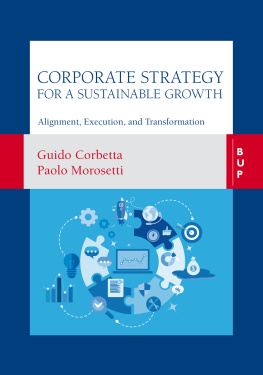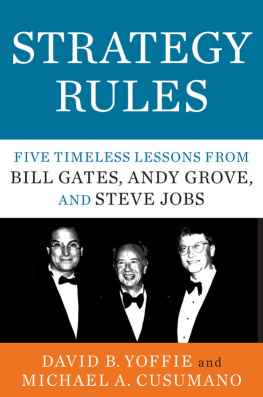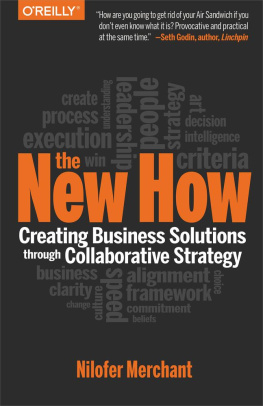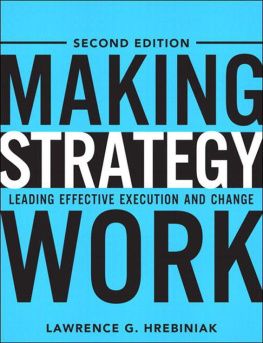Many companies have fallen victim to the trap of pursuing growth at all costs. Driving shareholder returns requires a different mind-set, which the authors have succinctly captured.
ANDREW CLYDE, President and CEO, Murphy USA Inc.
In an increasingly complex world, Paul Leinwand and Cesare Mainardi make a compelling case for sustained business success via simplification and focus. Linking strategy and execution through a set of differentiating and coherent capabilities is a winning idea, making Strategy That Works a fresh and inspiring read to help answer todays leadership challenges.
BENNO DORER, CEO, The Clorox Company
In a refreshingly pragmatic guide, Leinwand and Mainardi describe how senior leaders can bridge the gap between strategy development, execution, and delivery of results.
NEIL C. MCARTHUR, CEO and Chairman of the Executive Board, Arcadis NV
Leinwand and Mainardi have laid out a playbook for executives to close the strategy-to-execution gap, lighting a path for businesses that want to become more profitable and more influential, and delivering invaluable insight for CEOs who aspire to be supercompetitors.
ERIC A. SPIEGEL, President and CEO, Siemens Corporation
Strategy That Works provides a clear and compelling framework for executives to use in developing a cohesive and effective strategic vision. It provides a behind-the-scenes look at the characteristics of unconventional leadership and the importance of culture and identity as foundational components of a strong corporate strategy. Using tangible examples, this book presents the transformational journey that companies across all industries have undergone to remain successful and relevant in the twenty-first century.
MARK T. BERTOLINI, Chairman and CEO, Aetna
Any successful large enterprise must remain entrepreneurial, changing as needed to continue to do pioneering work. It must strike the right balance between openness to change and having a powerful, long-lasting core identity. Strategy That Works shows how to bring these two contrasting ideas together.
ZHANG RUIMIN, Chairman and CEO, Haier Group
Leinwand and Mainardi show you how to transform your value proposition into real results.
MARSHALL GOLDSMITH, author, New York Times #1 bestselling Triggers and global bestsellers MOJO and What Got You Here Wont Get You There
Strategy is all about making clear plans and sticking to them. Yet organizations get easily distracted. This great new book explains how to gain coherence across an organization in strategy setting and execution.
SALLY BLOUNT, Dean, Kellogg School of Management, Northwestern University
Strategy That Works is simple and astonishing at the same time. Coherence is a critical ingredient for success, but it is so difficult to find such coherence in organizations. This book will help you think about whether your organization is really aligned with your strategy: from the companys value proposition to its distinctive capabilities to the products and services it provides.
ALESSANDRO CARLUCCI, former CEO, Natura
A great book! Strategy That Works demonstrates how capabilities shape successful markets, enable winning companies, and sustain on-target execution. The case for capabilities-driven strategy strengthens with every turn of the page.
KARIM MICHEL SABBAGH, President and CEO, SES
STRATEGY THAT WORKS
HOW WINNING COMPANIES CLOSE THE STRATEGY-TO-EXECUTION GAP
Paul Leinwand
Cesare Mainardi
with Art Kleiner
HARVARD BUSINESS REVIEW PRESS
Boston, Massachusetts
HBR Press Quantity Sales Discounts
Harvard Business Review Press titles are available at significant quantity discounts when purchased in bulk for client gifts, sales promotions, and premiums. Special editions, including books with corporate logos, customized covers, and letters from the company or CEO printed in the front matter, as well as excerpts of existing books, can also be created in large quantities for special needs.
For details and discount information for both print and
ebook formats, contact ,
tel. 800-988-0886, or www.hbr.org/bulksales.
Copyright 2016 PwC
All rights reserved
Printed in the United States of America
PwC refers to the PwC network and/or one or more of its member firms, each of which is a separate legal entity. Please see www.pwc.com/structure for further details. Mentions of Strategy& refer to the global team of practical strategists that is integrated within the PwC network of firms. For more about Strategy&, see www.strategyand.pwc.com.
No part of this publication may be reproduced, stored in or introduced into a retrieval system, or transmitted, in any form, or by any means (electronic, mechanical, photocopying, recording, or otherwise), without the prior permission of the publisher. Requests for permission should be directed to , or mailed to Permissions, Harvard Business School Publishing, 60 Harvard Way, Boston, Massachusetts 02163.
The web addresses referenced in this book were live and correct at the time of the books publication but may be subject to change.
Library of Congress Cataloging-in-Publication Data
Leinwand, Paul, author.
Strategy that works : how winning companies close the strategy-to-execution gap / Paul Leinwand and Cesare Mainardi; with Art Kleiner.
pages cm
ISBN 978-1-62527-520-2 (hardback)
1. Strategic planning. 2. Management. 3. Organizational effectiveness. I. Mainardi, Cesare, author. II. Title.
HD30.28.L44933 2016
658.4012dc23
2015026915
ISBN: 9781625275202
eISBN: 9781625275219
To those we love.
CONTENTS
Overcoming the Strategy-to-Execution Gap
Almost every business today faces major strategic challenges. The path to creating value is not clear.
In one ongoing global survey of senior executives conducted by Strategy&, PWCs strategy consulting business, in recent years, more than half of the forty-four hundred respondents said they didnt think they had a winning strategy.
These problems are not caused simply by external forces. They are the outcome of the way most companies are managed. There is a significant and unnecessary gap between strategy and execution: a lack of connection between where the enterprise aims to go and Some business leaders try to close the gap on the strategy side, looking for a better market position. Others double down on execution, improving their methods and practices. Despite their efforts, both groups struggle to achieve consistent success.
Yet a few companies seem to have this problem solved. They naturally combine strategy and execution in everything they do. Their products and services have an enviable position in the markets they care about, and they reliably deliver on their promises. At every level of the hierarchy, from the top to the front lines, they seem to have an uncanny ability to make the right choiceseven when those choices run contrary to the conventional wisdom of their industry. Each of these firms has its own unique way of competing, but they all have one thing in common. Their success is clearly related to the distinctive way they do things: their capabilities.
Consider these three examples:
In the early 1950s, a young European entrepreneur decides to sell elegant, functional, inexpensive furniture so that people without much money can have better lives. To draw customers to his relatively remote retail store, he designs it so shoppers can comfortably spend all day, eating in the stores restaurant and leaving their children in its play area. His business rapidly grows, opening new stores and attracting employees who share a blunt, frugal, and empathetic perspective. Together, they build a remarkable group of capabilities, including an innovative manufacturing and supply chain; a proficiency in designing elegant furniture that ships in a flat box; and a keen ability to understand the way customers live at home and translate that insight into new products. Gradually this business expands to many other countries, becoming the worlds largest home furnishing enterprise. Its name, of course,
Next page





